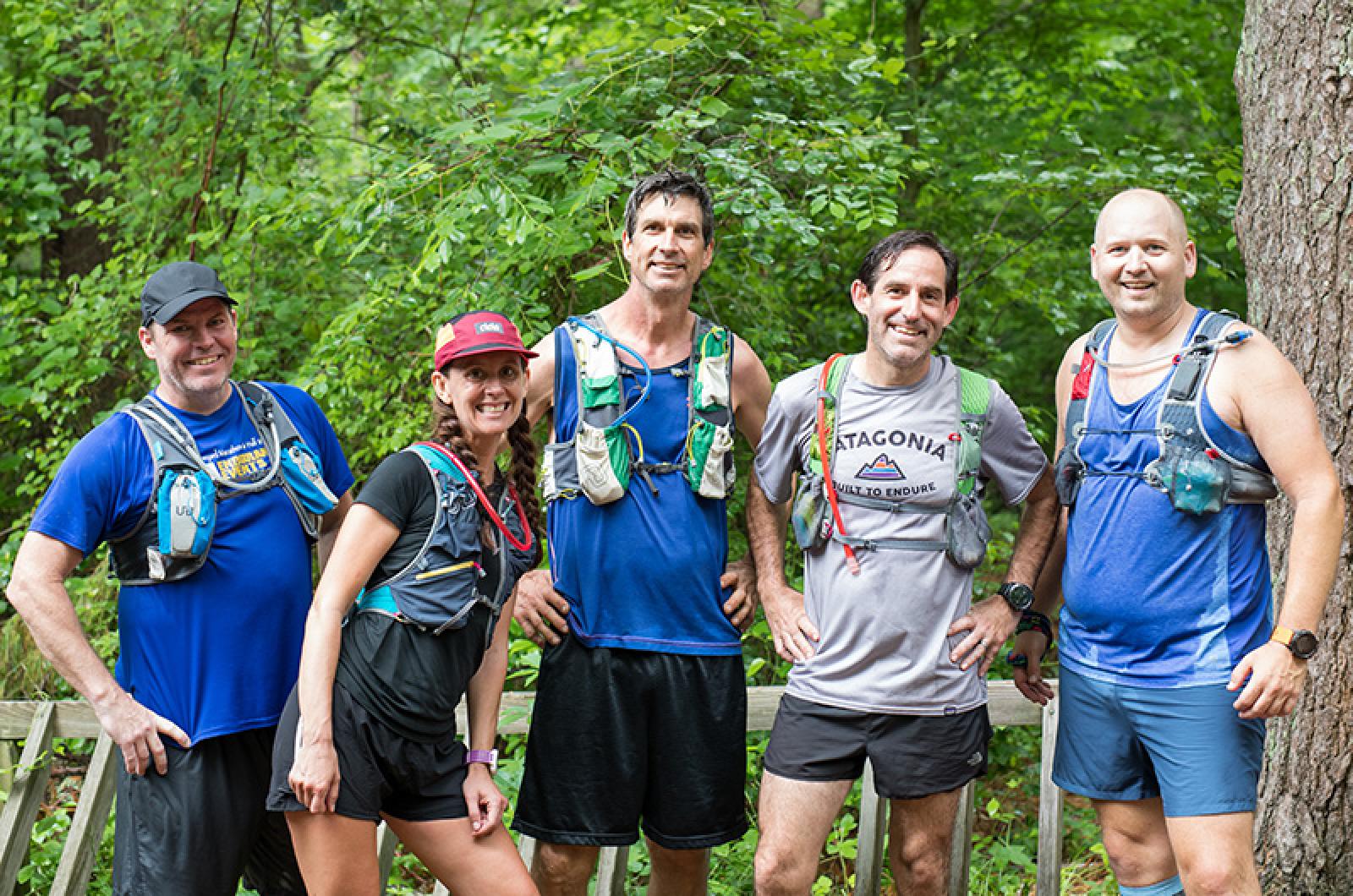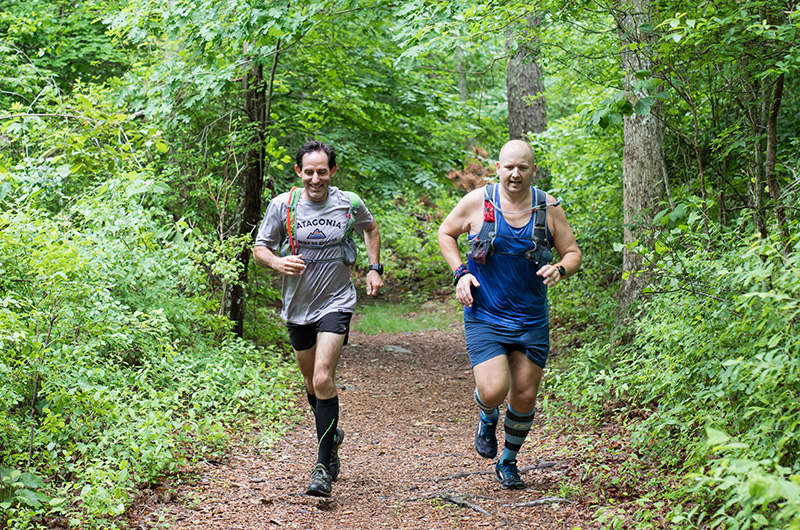The speed is not all that important, and the final time is estimated in hours, not clicked to a tenth of a second on a stopwatch. They are not running to be first across the line, or first in their age group. They just run. And run, and run and run.
A small core of dedicated Vineyard runners train year round for ultra-distance running. A Sunday morning run usually takes four hours. When they enter a race, it’s often a 50-miler, which can take about nine hours to complete, or even a 100-miler, which can take more than 20 hours.
By comparison, a 100-mile race is about like running a marathon (26.2 miles) and then running from Woods Hole to Provincetown, all in the same outing.
They push their bodies to the limit of human endurance, and love it.
David Diriwachter owns Auto Europa, an automobile repair shop in Vineyard Haven. He is the unofficial leader of the group that meets most Sunday mornings for a trail run of 15 to 20 miles.
He was a high school athlete, but gave up running until many years later. He wasn’t happy with his life.
“I was overweight, I was stressed out, I was unhealthy,” Mr. Diriwachter said.
When he did take up running again, he was good at it. Very good. In one weekend he won two road races, but realized that kind of running was likely to lead to more injuries and less personal satisfaction.
“I started running in the woods,” he said.
The Island’s vast system of trails proved to be a perfect training track. Mr. Diriwachter began to recruit friends to join him, and several converted from roads to trails quickly.
One step led to another, and soon the group was meeting every Sunday morning for a run that became as much a spiritual experience as fitness training.
Last year, Mr. Diriwachter completed the Javelina Jundred, a 100-mile race in the Arizona desert. He is training now for a 50-miler in Vermont, and hopes to return to Arizona again this year.
In one of his first ultra-distance events, Mr. Diriwachter learned a lesson about preparation and perseverance. The terrain and environment for each race is different and presents different problems.
“I was running really fast down hill,” he said. “I thought it was like free speed. It’s not free. It comes at a price. I found myself at mile 19, with 31 miles to go, rubbing cramps out of my quads with a muddy rock. The lesson that day is that ultra-running is not about planning to make sure nothing goes wrong, ultra-running is about being prepared to problem solve when something goes wrong, because something always goes wrong.”
His goal for next year is the Ultra Trail du Mont Blanc, a 100-mile race which begins in France, and takes a field of 8,000 runners around Mont Blanc into Switzerland, Italy, and back to France.
He said running a 100-mile race is as much a mental feat as a physical accomplishment. Running for more than 20 hours induces a lot of mental ups and downs.
“In the long races, you go back and forth,” Mr. Diriwachter said. “Somewhere along the line you’re forced into this place where you simply exist, and there’s nothing, and everything. If you don’t get there, you can’t do it.”
Whit Hanschka, who makes hand-crafted iron, bronze, and steel for architects and builders, joined the Sunday morning ultra-runners a little more than a year ago, and has since been inspired to compete in two ultra-distance events.
The group credits Mr. Hanschka for defining the kind of fun they have while training and competing. He calls it “type two” fun.
“It morphs from fun into torture, while you’re doing it,” Mr. Hanschka said. “But when you look back at it you’re really glad that you did it, and you think of it as fun.”
Erin Tiernan, part owner of the Oak Bluffs clothing stores Eastaway and Basics, was competitive in local middle and marathon distance races when she began trail running. Now the marathon distance doesn’t hold much interest for her.
“Fifty kilometers is about the shortest I like to go,” Ms. Tiernan said. “I said for years I would never do more than a marathon. Then I just drank the Kool-Aid.”
She is training for the Palo Duro Trail Run in October, a 50-mile race in Texas.
“It’s the push,” she said when asked what appeals to her about ultra-running. “It’s amazing how you can just keep pushing to that next level. It’s just freeing, all you’re thinking about is how to make it through the race.”
Todd Cleland is the race director for the Island’s popular 20-miler in February, a race that falls into the timing of a typical training schedule for the Boston Marathon.
His personal focus now is on trail running, and the camaraderie of the ultra-running group.
“I started running for the fitness benefits, and quickly realized the mental benefits,” Mr. Cleland said. “It’s a bigger challenge, it’s pushing yourself to the limit. They push you further than you would push yourself. You can’t slack off, they won’t let you.”
Anthony Holand is a metal sculptor who makes many of the distinctive wind vanes seen around the Island and across the United States. A few years ago, he found his weight nearing 300 pounds, and his life out of whack with stress and work. He began to exercise and run a little, thinking five miles was a big deal.
One day he accepted an invitation to run with Mr. Diriwachter. He was soon a regular on the trails. He found himself achieving more in trail running than he ever thought possible. Last summer, he signed up for a 50-kilometer (31 miles) race on Cape Cod. The race was organized as five consecutive 10-kilometer loops along a wooded trail.
“The thought was I’ll sign up for it, and if something goes south, I’ll just bail out on a loop, easy enough,” Mr. Holand said. “So I pulled it off. I remember my watch dinged and I looked down. Hey there’s a marathon, nice. Five more miles. You run a marathon by default.”
Mr. Holand burns 1,100 calories an hour during a race. There are aid stations set up on each course with a surprising variety of foods available to replace those calories.
In one race last year, he found a choice of sandwiches, pizza, pumpkin pie, peanut butter and jelly sandwiches, M&Ms, grilled steak or chicken, chips.
“Myself running down the trail with a handful of Pringles was kind of funny,” Mr. Holand said. “It’s amazing the things you’ll eat.”
Like his running companions, Mr. Holand credits the little group of Vineyard ultra-runners with helping to learn the mental toughness necessary to finish a race. He never doubts he can finish.
“It’s not the 100 kilometers or the 100 miles, it’s the 1,200 miles before that that you have to think about,” Mr. Holand said. “It’s all the stuff that gets you to that point. Then it’s all mental. Physically, you can do it. It’s brutal, but you can get it done. There’s comfort in discomfort, I guess. It’s weird feeling.”





Comments (2)
Comments
Comment policy »